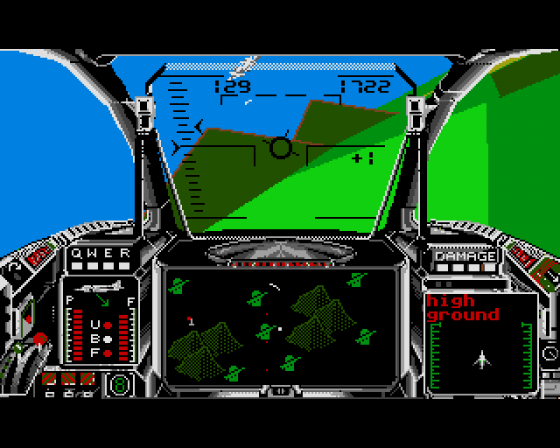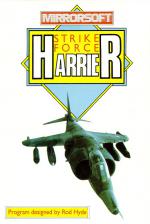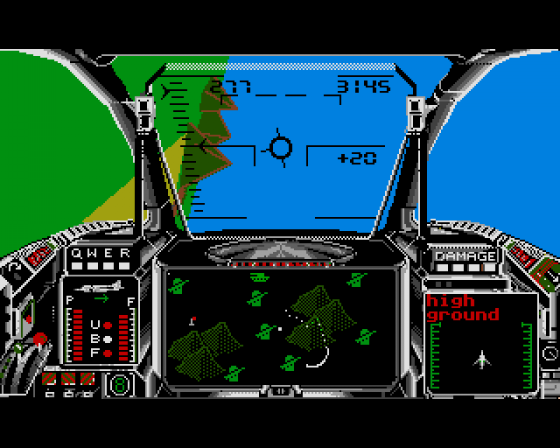
Commodore User
 1st April 1988
1st April 1988
Categories: Review: Software
Author: Ian Frogsac
Publisher: Mirrorsoft
Machine: Amiga 500
Published in Commodore User #55
Strike Force Harrier
With films like Top Gun continually publicising American Fighters such as the F-14 Tomcat and the F-16, I for one had almost forgotten that in the Harrier, the Brits have one of the world's best all-round fighter planes and the only one capable of vertical take-off and landing.
Strike Force Harrier puts the player in control of a Harrier, although the one in this game apparently has a few tricks up its sleeve that even the RAF have yet to manage to install in theirs!
As the version I reviewed only left the distribution company a matter of minutes before arriving in my grubby little mitts, both the instruction book and the key guides were meant for the Atari ST, but after a few minutes scanning I was blasting bogeys at 20,000 feet with the best of them. By the way, while on the subject of the manual, I must say that although it explains most of the game's vital areas, it does seem to have a bit of a gap when it comes to using the weaponry, but hopefully that will be included in the finished version.

What Mirrorsoft, or rather the programming team behind Strike Force Harrier, have managed to do that is so essential in this type of game is give the player enough to play with immediately so he will want to delve further and discover the true depths of the game. You do not have to read the whole manual simply to spend five minutes hunting and destroying baddies, but if you spend a while with the game, looking at the smallish manual, you can find a whole lot more than a glorified shoot-'em-up.
On the screen of the Amiga, Strike Force Harrier has a variety of on-screen information. The top two-thirds of the screen is a full 'live-action' display of what is going on around you. Below that is the Friend or Foe Tracking Radar, or FORTRAC to its mates. This piece of equipment is completely vital if you are to achieve even relative success. It not only shows you where your base and those of the enemy are, it also serves to warn you as to the direction of oncoming missiles. You may not have a co-pilot in the game, but FORTRAC makes up for that (though he's not much fun in the pub after missions!).
Other parts of the screen act as an attack radar (more information on your impending doom), a damage indicator, and the usual power/undercarriage/thrust indicators. Facts such as air speed, height, roll indicator and heading are all displayed in the centre of the screen, as are the targetting computers.

The targetting computers themselves are terribly clever little devils. When there is an enemy in your firing line, the outside of your circular aim turns red, and you can then fire your cannons. If you have any missiles left (and as you are only equipped with two to start with, you are lucky if you don't use them within the first ten seconds) a green cross-hair appears and indicates that you have locked on to an enemy and should launch one of these unerringly accurate missiles. Call me brutal, call me vicious, but I can tell you there is little in the world more satisfying than launching a missile that you know isn't going to miss!
Bombs, of which you have three at the beginning of each sortie, are a great deal more difficult to use and require planning and great skill. Suffice it to say that in many hours play I hardly bombed anything successfully. I have been reliably informed that it is very simple... pah! Once you have decided on a target, you must launch your bombs at just the right moment, and then hope. What I want to know is why they can't have heat-seeking bombs, that refuse to land until they've found an enemy base?
Of course, you also have normal machine gun fire. Although not too useful against enemy planes, they are terribly good for flying low and blasting land-based enemies out of sight.
Unlike many flight sims I have seen, the graphics on Strike Force Harrier are actually pretty good. The enemy planes are distinctive, and the scrolling is smooth enough to do justice to the game. One very nice touch is the FORTRAC map/radar, which really is very pretty indeed. Sound too, is not bad; you hear satisfying screams as you release sidewinders, although the machine guns sound a little weedy. Some speech is included too, which shows the the game was not simply the ST conversion that some people said it would be.
Overall, then, it is safe to say that Mirrorsoft have released another cracker. It is refreshing to see that English companies are starting to release software that will have the Americans gushing over it the way we all gushed over Defender Of The Crown.









